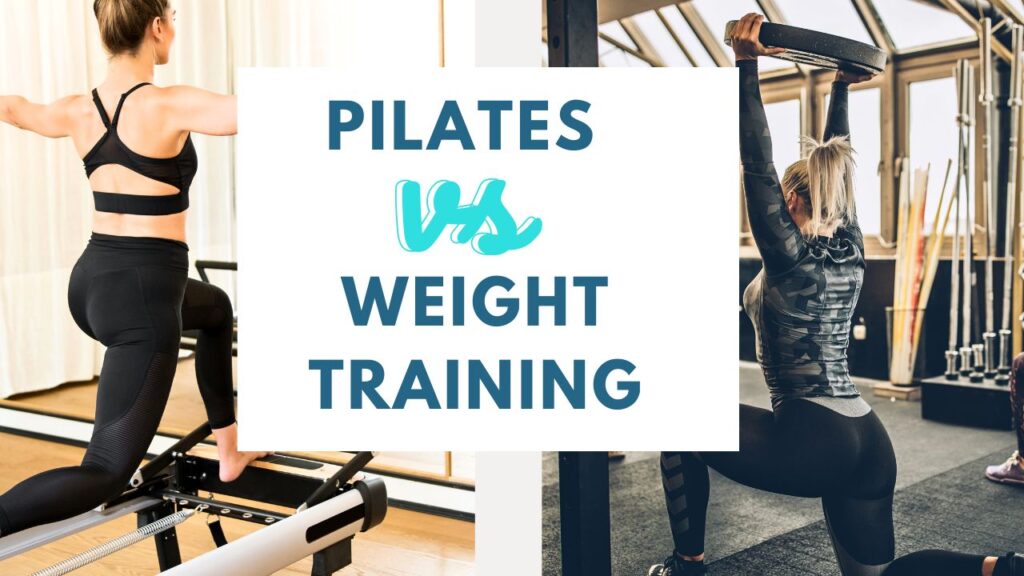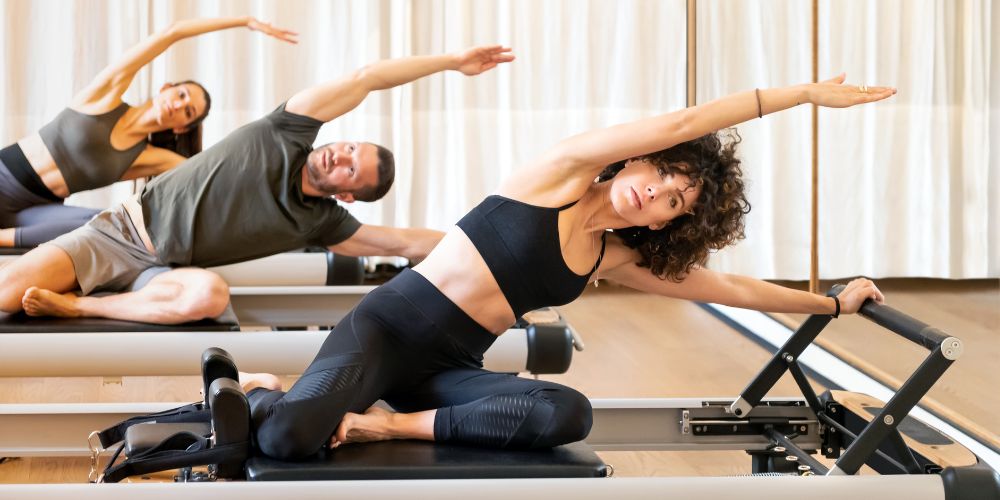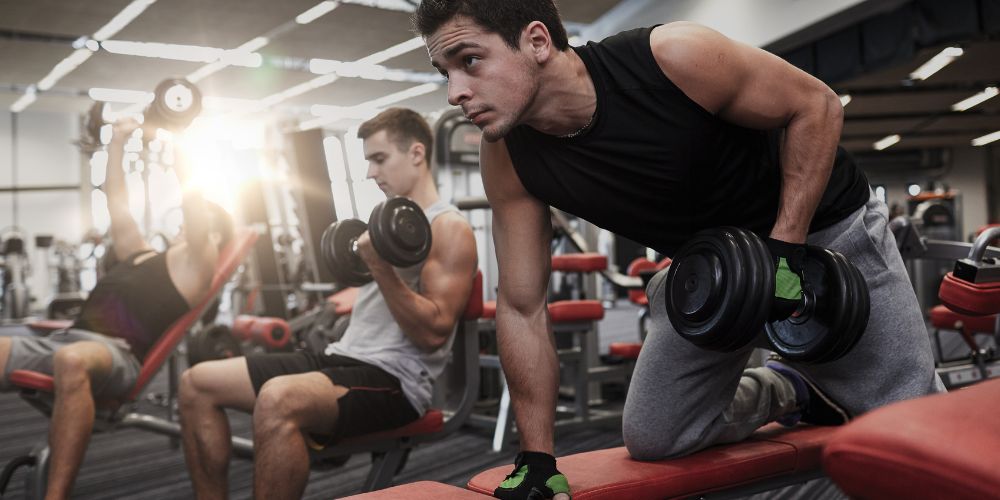
Are you torn between the grace of Pilates and the raw strength of weight training? Do you wonder if you can build muscle and stay injury-free? This is the topic that we will cover today to help you gain in-depth knowledge about both Pilates and weight training, clear off any misconceptions and help you create a balanced and effective fitness routine.
Key Takeaways
- Both Pilates and Weight training are types of strength training.
- Pilates uses springs and body weight for resistance while weight training uses weights, barbells, and weight machines for resistance.
- Does Pilates build muscle? Not really, if we are talking about muscle growth/hypertrophy.
- Building muscle with just Pilates can be challenging due to its inherent limitations, such as fixed resistance from springs and the variable tension that doesn’t always allow for the consistent overload required for muscle hypertrophy.
- Pilates excels in end-range control and stability rather than in the significant muscle growth typically associated with traditional weight training.
- Combining weight training with Pilates can lead to improved strength, flexibility, injury prevention, and overall physical fitness.
- Complementary Strengths: Weight training offers the ability to progressively lift heavier weights, essential for muscle growth, while Pilates enhances core strength, stability, and body awareness.
- Injury Prevention: Pilates improves body control and awareness, which can help prevent injuries during weight training by ensuring proper form and technique.
- Enhanced Performance: The core strength and stability gained from Pilates can improve performance in weight training, allowing for safer and more effective lifting.
- Holistic Fitness: Combining Pilates and weight training provides a balanced approach to fitness, addressing various aspects of strength, flexibility, control, and muscle growth.
- Versatility in Workouts: Integrating Pilates principles into weight training routines and vice versa can create a more functional and targeted workout, making individuals well-rounded and physically fit.
Is Pilates Strength Training?
Before we dive deeper into our discussion of weight training vs Pilates, I want to pause right here and say this “Pilates IS Strength Training.”
I feel that we need to get the terminology straight here first. Many people use “strength training” and “weight training” interchangeably which adds to the confusion when they try to pick the right type of training for them or compare the benefits with another modality like Pilates.
What is Strength Training?
Strength training, or resistance training, is a form of physical exercise specializing in the use of resistance to induce muscular contraction, which builds the strength, anaerobic endurance, and size of skeletal muscles.
What is Weight Training?
Weight training is a type of strength training that uses weights for resistance. This method focuses on increasing the strength, size, and endurance of muscles by lifting varying weights, including free weights like dumbbells and barbells, or using weight machines.
What is Pilates?
Pilates is a form of low-impact exercise that emphasizes controlled movements that strengthen the body, particularly the core muscles, through resistance provided by one’s own body weight, gravity, and specialized equipment that uses spring resistance.
As you can see, Pilates is a type of strength training because it utilizes resistance but it is different from the traditional strength training methods that focus on increasing muscle mass and strength by lifting heavy weights. While it may not build muscle in the same way that lifting heavy weights does, Pilates definitely contributes to building muscle strength and endurance, making it a valuable component of a well-rounded fitness regimen.
Pilates Studio vs Weight Room
Now that we set our terminology straight, let’s get back to the main topic of the article: Pilates vs Weight training. There are distinct stereotypes that are associated with both Pilates and weight training.
- Pilates is stereotypically considered a stretching workout that only women and ex-dancers engage in.
- And weight training is only for men who want to look like Arnold back in his glory days (prior to his open-heart surgeries.)
Is there any truth to these stereotypes?

Pilates is a Workout for Women
Have you ever seen one of the following statements on the pages of a Pilates website, magazine or in a social post:
Real Men Do Pilates.
Created by a Man for Men
Real Man’s Workout
These statements are designed to “lure” men into a Pilates studio and show the merits of the Pilates method.
- If you walk inside any studio, you will see that most of the clients are women.
- If you search Instagram feed for Pilates inspiration, you will see predominantly women.
- If you go on PilatesAnytime or Pilatesology, you will see mostly Female teachers.
Despite the fact that Contrology (the original name of the Pilates method) was developed by a man, today it is viewed as a fitness modality predominantly for women.
Don’t get me wrong, I have personally worked with male clients in my career as a Pilates teacher and I know many incredible male Pilates teachers. However, women are naturally drawn to Pilates because of its graceful and low-impact nature.

Weight Room is for Men Who Grunt
Now let’s step inside a gym. Who do you see there pumping weights? Mostly men. Granted, you will see more women inside a gym than you will see men in a Pilates studio, but the disproportion is still clearly visible. You will also notice that most women in a gym gravitate towards cardio equipment instead of the weight racks or benches.
Here is the statement that I want to make for this article:
Real Men Do Pilates and…. Real Women Lift Weights
While men can definitely benefit from Pilates, we shouldn’t forget that women will also benefit from weight training. The activities that we tend to resist the most are usually the ones that will benefit our bodies and overall fitness the most.
My Story with Weight Training and Pilates
I have a long-lasting love story with Pilates. I fell in love with it in high school, pursued my dream to become a Pilates teacher, was able to go through and recover after 2 twin pregnancies and today I help Pilates teachers touch and transform the lives of people through the Pilates method by creating websites that grow their businesses.
Weight training, on the other hand, was never my passion. I dabbled in it, but did not find it as engaging or energizing as Pilates workouts. It lacked the grace and flow elements of a Pilates practice.
I first started going to the gym with my husband. It was a purely time-saving decision: by working out at the gym we could still spend time together and fit in a workout into our busy schedules while our kids were at their after-school activities.
Fast-forward to today, I look forward to going to the gym with my husband and now also with one of my daughters. And I love how much stronger weight training has made me and how it elevated my Pilates practice.
A few months ago I made an unexpected discovery. I couldn’t come to the Pilates studio for my personal workouts for a couple of weeks but I was able to hit the gym 4-5 times a week. When I finally made it to the Pilates studio this happened: my Pilates workout felt so much easier and smoother! The moves that were a challenge before (teaser on the chair, single-leg pull-up on the chair, going up-front) were a breeze.
The Pilates principles that were ingrained in my body helped me have good control of my body and maximize my output at the gym while lifting weights while the muscle strength built through weight lifting gave me the extra edge to take my Pilates practice to the next level.
Pilates and Weight Training are a Perfect Match, Especially for Women
We started this article by discussing the differences in how men and women view exercise. I would really love to get my point across to all the women: weight training is not scary and it is extremely beneficial for us!

I am not the only one thinking like that. Recently I talked to Kim Moscatello in the PilatesBridge Featured Expert Series and we discussed this exact topic. Kim is a Pilates teacher who challenges the norms and is not afraid to mix different movement modalities to create a more functional and targeted workout. In her words, “There are elements missing from both Pilates and the traditional gym environment. By integrating the best of both worlds, we can prepare individuals for almost anything, making them well-rounded and physically fit.”
Benefits of Pilates
Since you are reading this article on the pages of a website devoted to Pilates, I bet you are already sold on all the benefits of Pilates. And if you need a quick refresh, you can read the benefits of doing Pilates here and more Pilates benefits here.
Benefits of Weight Training for Women
Since women tend to resent weight training the most I want to focus specifically on the benefits of weight training for women. In my opinion, the biggest benefit is how weight training can prepare women for menopause. There are many changes happening in a woman’s body during menopause, and weight training can prevent many of the problems associated with this change.
- Hormonal Balance: Weight training helps regulate hormones, alleviating menopausal symptoms such as hot flashes and mood swings.
Source: Daley, A., Stokes-Lampard, H., & MacArthur, C. (2007). Exercise for vasomotor menopausal symptoms. Cochrane Database of Systematic Reviews. - Bone Health: Weight training enhances bone density, reducing the risk of osteoporosis during menopause.
Source: Kemmler, W., & Von Stengel, S. (2013). Exercise and osteoporosis-related fractures: A review of the literature. European Journal of Physical and Rehabilitation Medicine. - Muscle Preservation: Weight training preserves and builds lean muscle mass, aiding weight management and countering age-related muscle loss during menopause.
Source: Phillips, S. M. (2012). Nutritional supplements in support of resistance exercise to counter age-related sarcopenia. Advances in Nutrition. - Weight Management: Weight training helps burn calories, improves body composition, and addresses weight gain often associated with menopause.
Source: Villareal, D. T., et al. (2017). Aerobic or resistance exercise, or both, in dieting obese older adults. New England Journal of Medicine. - Heart Health: Weight training can lower blood pressure and improve overall cardiovascular health, reducing cardiovascular risk during menopause.
Source: Steven Mann, Christopher Beedie, Alfonso Jimenez, et al. (2014). Differential Effects of Aerobic Exercise, Resistance Training and Combined Exercise Modalities on Cholesterol and the Lipid Profile. Sports Medicine. - Joint Health: Weight training strengthens muscles around joints, reducing joint pain and stiffness commonly experienced during menopause.
Source: Elizabetta Bacchi, Carlo Negri, et al. (2012). Resistance training effects on metabolic function in patients with type 2 diabetes. Diabetes Care. - Improved Sleep: Regular weight training can improve sleep quality, addressing sleep disturbances often associated with menopause.
Source: Baron, K. G., et al. (2013). Exercise to improve sleep in insomnia: Exploration of the bidirectional effects. Journal of Clinical Sleep Medicine. - Mood Enhancement: Weight training releases endorphins, improving mood and reducing mood swings, anxiety, and depression during menopause.
Source: Nabkasorn, C., et al. (2006). Effects of physical exercise on depression, neuroendocrine stress hormones, and physiological fitness in adolescent females with depressive symptoms. European Journal of Public Health. - Enhanced Functional Fitness: Weight training enhances overall functional fitness, making daily tasks easier to perform during menopause, improving overall quality of life.
Source: Cadore, E. L., et al. (2013). Multicomponent exercises including muscle power training enhance muscle mass, power output, and functional outcomes in institutionalized frail nonagenarians. Age. - Pelvic Floor Health: Weight training combined with targeted resistance exercises can improve pelvic floor strength, addressing issues like urinary incontinence during menopause.
Source: J P Theofrastous, et al. (2015). Effects of a pelvic floor muscle training program on muscle strength and urinary incontinence. Neurourology and Urodynamics. - Stress Reduction: Weight training provides a healthy outlet for managing stress, helping women cope with the physical and emotional changes of menopause.
Source: Stults-Kolehmainen, M. A., & Sinha, R. (2014). The effects of stress on physical activity and exercise. Sports Medicine.
Some of these benefits correlate directly with the benefits of Pilates, while others provide complementary effects that promote better health and more active aging.
Pilates Approach to Building Strength
One of the unique aspects of Pilates is its use of springs as resistance. Pilates apparatus, including the famous springs, offers controlled resistance and challenges your core and spinal control in an inherently unstable environment. While Pilates may not involve lifting heavy weights, it excels in end-range control and stability.
Let’s explore the benefits of Pilates and how it complements weight training as a strengthening routine:
- Core Strength: Pilates is unparalleled in its ability to strengthen the core muscles, improving posture and stability. This is essential for both men and women, especially those prone to back pain. (Source: Journal of Physical Therapy Science)
- Functional Movement: Pilates places a strong emphasis on functional movement patterns, making it valuable for daily activities and injury prevention. This complements the more controlled environment of weight lifting. (Source: Journal of Bodywork and Movement Therapies)
- Mind-Body Connection: Pilates fosters a deep mind-body connection, enhancing body awareness and control. You can say that this connection is the “secret juice” that helps prevent injuries and makes every other activity that you are involved in better.
Limitations associated with Pilates springs when it comes to strength training
- Fixed Resistance: Pilates springs always provide a fixed weight or resistance, regardless of adjustments. This limitation means you cannot surpass the specific resistance provided by the springs.
- Variable Tension: Unlike traditional fixed-weight dumbbells, springs offer variable tension throughout an exercise. The resistance is at its maximum when fully extended and decreases during the initial pull.
Can you build muscle with Pilates?
Building muscle with just Pilates can be challenging due to certain inherent limitations. Pilates primarily focuses on overall body control, core strength, and flexibility, engaging multiple muscle groups simultaneously. However, it may not provide optimal conditions for significant muscle growth.
- One limitation is that Pilates often utilizes spring resistance, which offers fixed weight/resistance that cannot be adjusted beyond a certain point.
- The resistance from Pilates springs varies during exercises, making it challenging to achieve the consistent overload required for muscle hypertrophy.
- Pilates’ emphasis on stability and controlled movements may not provide the ideal environment for targeting specific muscle groups with maximum intensity.
- In Pilates, positions and movements often require co-contraction of muscles against spring resistance, creating a stable yet challenging environment. However, this setup doesn’t always allow for the isolation of specific muscle groups, which is a common strategy in traditional weight training.
Weight Training Approach to Building Strength
Building muscle isn’t merely about lifting weights; it’s about challenging your body progressively. As Kim Moscatello emphasizes, “When it comes to building muscle, pushing beyond a weight plateau is crucial. This is how muscles grow in size.” You have multiple training methods to choose from at the gym from powerlifting and weightlifting that focus on heavy weights and few reps to build power to circuit training that incorporates a higher number of reps and lighter or body weights to aid in weight loss. In essence, regardless of the type of weight training that you choose, you need to continually increase the resistance or intensity of your workouts to stimulate muscle growth.
Weight training, especially in a gym setting, offers certain distinct advantages when it comes to strength training:
- You can lift progressively heavier weights, which is pivotal for muscle growth and overall strength.
- Weight training typically focuses on creating a stable environment for lifting, ensuring you can lift heavier loads with safety and precision.
- You can achieve greater intensity during your workout. Lifting heavier weights and incorporating compound movements helps build overall strength.
- You are able to isolate specific muscle groups using weight training equipment or free weights to address specific areas of weakness in your body.
- Lifting heavy weights and performing dynamic moves prepares us for real-life situations and helps to avoid injuries when we need to make sudden moves or pick up something heavy. For example, deadlift is one of my favorite all-time exercises at the gym. Knowing how to deadlift properly and being able to do it with a heavy weight has helped me personally multiple times avoid back injuries that I was prone to before.
How to Avoid Injuries When Lifting Weights
During my years of teaching Pilates, I’ve seen multiple clients who came to the studio because they got injured at the gym or while doing intense forms of exercise like CrossFit or HIIT. However, in most of the cases, the clients were not in great shape to begin with. They started these intense forms of exercise without knowing the proper form for the exercises that they were doing at the gym and not having body awareness to stay safe during high-intensity moves.
This is where the role of Pilates becomes crucial. Pilates helps you learn control of your body. This control and increased body awareness is what you can take into any movement modality to make it safer and more efficient.
- Learn to control your body in space: Working with springs will teach you to control your body in space, move a resistance load, and avoid relying on the momentum that might throw you off balance – something that often happens with free weights when the technique isn’t properly understood.
- Core Strength: Pilates places a strong emphasis on core strength and stability. Learning to activate your core muscles correctly helps improve form while doing weight lifting exercises, reducing the risk of injury, especially to the lower back.
- Improved Mobility: Pilates promotes flexibility and range of motion in the joints. Improved flexibility allows weight lifters to perform exercises with a full range of motion, reducing the risk of muscle pulls or strains.
Striking Balance Between Pilates and Weight Training
Pilates vs weight lifting: it’s not about choosing one over the other; it’s about finding harmony and balance. The key to harnessing the combined benefits of Pilates and weight training lies in incorporating both of them into your fitness routine.
“If you know how to incorporate Pilates into your gym routine and vice versa, you’ve hit the jackpot in terms of physical fitness.” – Kim Moscatello.
You have a lot of flexibility in how you can combine Pilates and weight training in your fitness routine. Whether you choose to bring elements of Pilates and weight training into one workout (like Kim does in many of her videos), or you want to practice the pure forms of these fitness modalities during separate workouts like I do – choose what feels right for your body. Approach your workouts with an open mind and curiosity and keep on challenging your personal limits!

